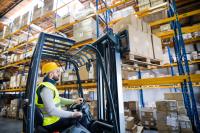 Add My Company
Add My Company
Sign In
WHY IS OVERLOADING A FORKLIFT DANGEROUS?
19-07-2022

WHY IS OVERLOADING A FORKLIFT DANGEROUS?
1,500 injuries are caused by forklifts and other industrial vehicles every year. Whilst unavoidable accidents can happen, many accidents can occur by misoperation or negligence of a forklift truck, which could easily be avoided if educated correctly.
Overloading a forklift truck is a key example of negligence which can cause unnecessary danger and could be the cause of many accidents. Overloading a forklift truck results in the forklift tipping and falling, which causes damage to both the vehicle and stock but most importantly, the individual operating it.
Close to one out of every four fatalities occurs when a forklift tips over. Forklifts can easily tip if they are overloaded, if the load is not well balanced, or if they travel with the forks too high.
Don’t Push The Limits
The majority of forklift operators understand the capacity of the machines they use and the importance of sticking to them. However, it is not uncommon for those who operate forklifts on a regular basis to become less strict with their weight load over time, attempting to put a little extra weight on to pallets or try to estimate the load sizes rather than weighing them. This is often what can cause forklift to be unstable and tip over, causing these accidents and injuries, and sometimes even fatalities.
Counterbalancing loads re designed to balance the weight of the forks plus the load with the weight of the truck itself held by the back axle. With the weight of the truck off setting the load, specific limits are required to keep the back of the forklift heavier, and the back wheels firmly on the ground.
These instructions must be adhered to due to the forklift being a moving vehicle. When a forklift is static it may look balanced with its rear wheels on the ground, but add speed, turning, lifting and moving into the mix and this is when your counterbalanced weight will feel the effects. This is then worsened by things like terrain and incline.
To be sure that the load on the forklift remains balanced, and secure during loading and transit is to always stay under the capacity limits.
Establish weight loads
Once you establish the load capacity, you should always strive to ensure you only load the forklift with loads within this weight capacity. The weight of the load can be found by its labelling, or by manually using a weight scale. Scales are usually attached to the hydraulic system of the forklift and they have sensors that measure the weight of the load placed onto the forklift. This way you can avoid overloading the forklift, and therefore avoid any accidents or injuries.
For more information on WHY IS OVERLOADING A FORKLIFT DANGEROUS? talk to H and F Lift Trucks
Enquire Now
List your company on FindTheNeedle.

